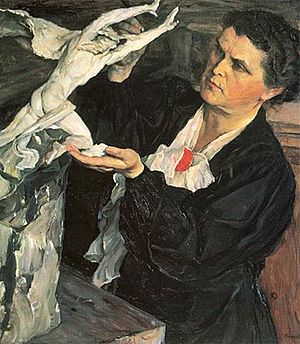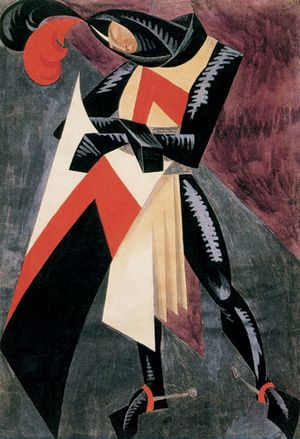Vera Mukhina facts for kids
Quick facts for kids
Vera Mukhina
|
|
|---|---|

Vera Mukhina; portrait by
Mikhail Nesterov (1937) |
|
| Born |
Vera Ignatyevna Mukhina
1 July 1889 Riga, Governorate of Livonia, Russian Empire
|
| Died | 6 October 1953 (aged 64) Moscow, Soviet Union
|
| Nationality | Russian |
| Known for | Sculpture |
| Spouse(s) |
Alexey Zamkov
(m. 1918; died 1942) |
Vera Ignatyevna Mukhina (born July 1, 1889 – died October 6, 1953) was a very famous Soviet sculptor and painter. People called her "the queen of Soviet sculpture" because of her amazing work.
Contents
Vera Mukhina's Early Life
Vera Mukhina was born in 1889 in Riga, which was part of the Russian Empire. Her family was wealthy. They lived in Riga after the Patriotic War of 1812.
When Vera was two, her mother died. Her father moved the family to Feodosia for Vera's health. There, she started learning to draw and paint. She lived in Feodosia until her father died in 1904. After that, her aunt and uncle in Kursk took care of Vera and her older sister. Vera finished high school with excellent grades.
A Life-Changing Accident
In 1912, Vera had a serious accident while sledding. She crashed into a tree, and her nose was badly hurt. She had many surgeries, but her face changed a lot. It became stronger and more determined-looking. This event greatly influenced her life and her future as an artist.
Studying Art in Europe
Vera moved to Moscow to study art. She attended several private art schools. In 1912, she traveled to Paris, France, to continue her studies. She learned from famous artists like Emile-Antoine Bourdelle.
Later, she went to Italy to study the art of the Renaissance period. Vera returned to Moscow in the summer of 1914, just before World War I began. She became a nurse in a military hospital. There, she met Alexei Zamkov, a military doctor, and they married in 1918.
Vera Mukhina's Art Career
After the October Revolution in Russia, the government started a plan to create many public monuments. Sculptors like Mukhina received special orders from the state. In 1918, she designed a monument for the educator Nikolay Ivanovich Novikov. However, the clay model was damaged, so the project was never finished.
Mukhina also created designs for sculptures like Liberated Labor and Revolution in 1919. She made monuments for important figures like Vladimir Mikhailovich Zakorskiy (1921) and Yakov Mikhailovich Sverdlov (1923).
Becoming a Leading Sculptor
In the 1920s, Mukhina became one of the most important sculptors in the Soviet Union. She became a leader in a style called Socialist realism. This art style focused on showing the lives of ordinary people and the achievements of the Soviet state.
In 1923, Mukhina helped design the pavilion for the Izvestia newspaper at an exhibition in Moscow. In 1925, she and fashion designer Nadezhda Petrovna Lamanova won a big award in Paris. They created stylish women's clothes from simple, cheap materials like cloth and canvas.
Mukhina also taught art at state schools from 1926 to 1930. In 1927, her sculpture Peasant Woman won first prize at an exhibition. This sculpture was later bought by a museum in Italy and is now owned by the Vatican Museums in Rome.
Famous Works and Public Monuments
Vera Mukhina became internationally famous for her 1937 sculpture, Worker and Kolkhoz Woman.
The Worker and Kolkhoz Woman Sculpture
This giant monument was the main attraction of the Soviet pavilion at the 1937 International Exhibition in Paris. Mukhina designed it to look like it was flying, showing the Soviet Union's hope for new successes. The French press called it "the greatest work of sculpture of the XX century." It was the world's first large welded sculpture.
The monument is 24 meters (about 79 feet) tall and weighs 75 tons. It was made from stainless steel plates joined by a new welding method. The two figures hold a hammer and a sickle, which together form the symbol of the Soviet Union.
After the exhibition, the monument was moved back to Moscow. It was placed near the VDNKH exhibition center. In 1947, this sculpture became the logo for the Russian Mosfilm movie studio. It was repaired and put on a taller base in 2009.
Other Notable Sculptures
From 1938 to 1939, Mukhina worked on sculptures for the Moskvoretsky Bridge in Moscow. These included Hymn to the International, Flame of the Revolution, Sea, Land, Fertility, and Bread. Only Bread was fully completed by Mukhina herself.
During World War II, she worked in Kamensk-Uralsky. In 1945, she helped save the Freedom monument in Riga from being destroyed. She argued strongly that it was an important work of art.
Mukhina created two monuments to the writer Maxim Gorky. One was put up in 1943 at the Belorussky Rail Terminal in Moscow. The other was installed in 1952 in Gorky.
Another famous work is the monument to the composer Peter Tchaikovski. It was placed in 1954 at the Moscow Conservatory. This sculpture is a main feature of the area.
Vera Mukhina continued to create official monuments and sculptures for the state until she died. She also experimented with glass and new ways to use colors in sculpture. She designed clothes, textiles, porcelain, and theater costumes.
From 1941 to 1952, Mukhina won the Stalin Prize five times. In 1943, she was named People's Artist of the USSR. Her influence helped save the Freedom Monument in Riga from being replaced by a statue of Joseph Stalin.
In 1953, she wrote a book called A Sculptor's Thoughts.
Death and Legacy
Vera Mukhina died in Moscow on October 6, 1953, from a heart condition. She is buried in Novodevichy Cemetery in Moscow.
A museum dedicated to Vera Mukhina's early life and work was opened in Feodosiya, Crimea, in 1985. There is also a street named after her in the town of Klin. A crater on the planet Venus is also named in her honor.
Vera Mukhina's Works
In Moscow
- Worker and Kolkhoz Woman
- Sculpture Science at the MSU building
- Sculptures Bread and Fertility (also called Harvest) in Druzhba Park
- Sculptures Earth and Water (also called Sea) at Luzhniki Stadium
- Monument to Peter Tchaikovski at the Moscow Conservatory
- Monument to Maxim Gorky at the Belorussky Rail Terminal
- Monument to Maxim Gorky at the Institute of World Literature
- Seven tombstones at Novodevichy Cemetery
In Other Cities
- Sculpture Mir in Volgograd
- Sculptural group Farhad and Shirin for the Farkhad hydroelectric power station
- Monument to Maxim Gorky in Nizhny Novgorod
- Sculpture Mir on the roof of the planetarium in Volgograd, which was Mukhina's last work
See also
 In Spanish: Vera Mújina para niños
In Spanish: Vera Mújina para niños


